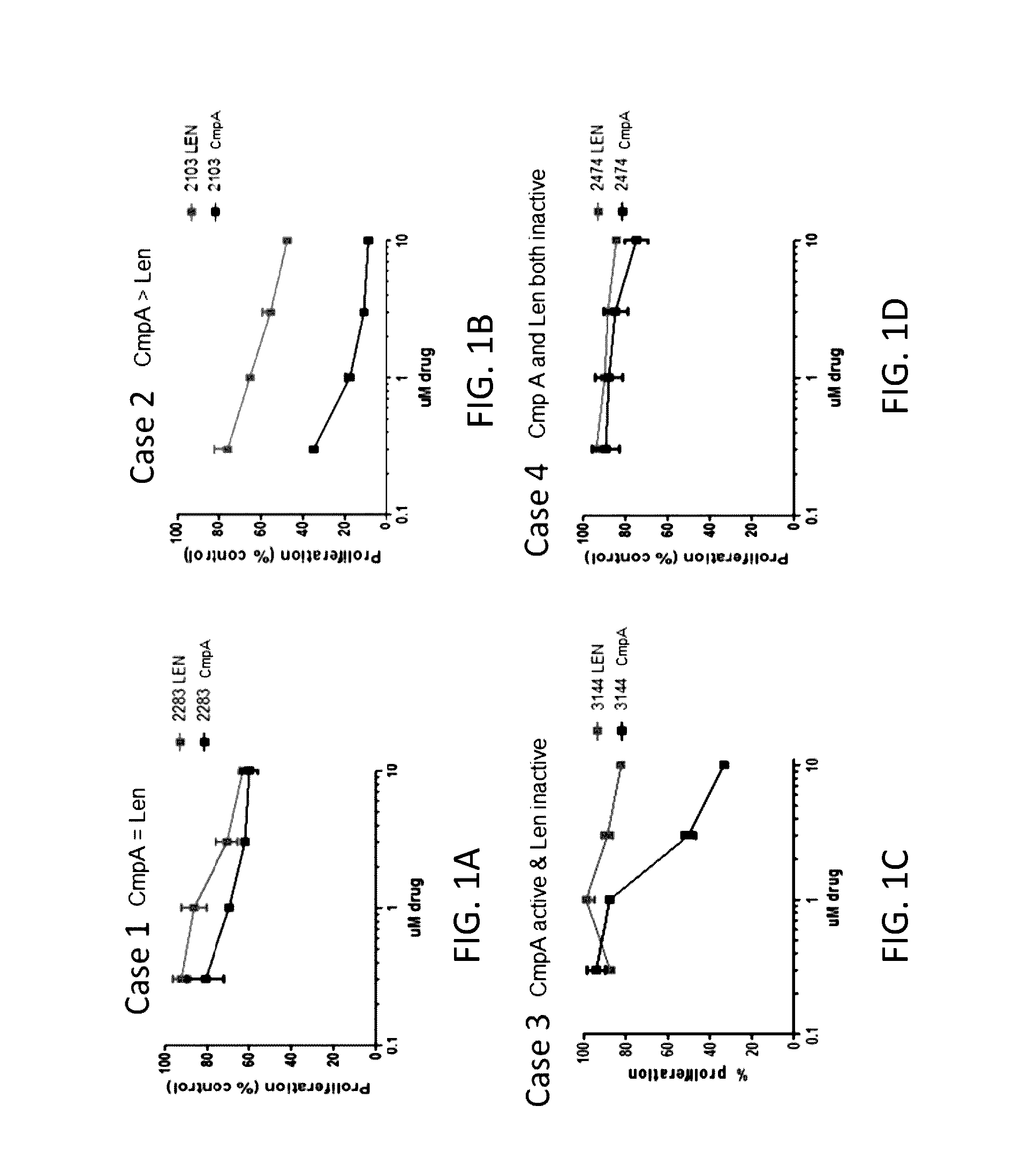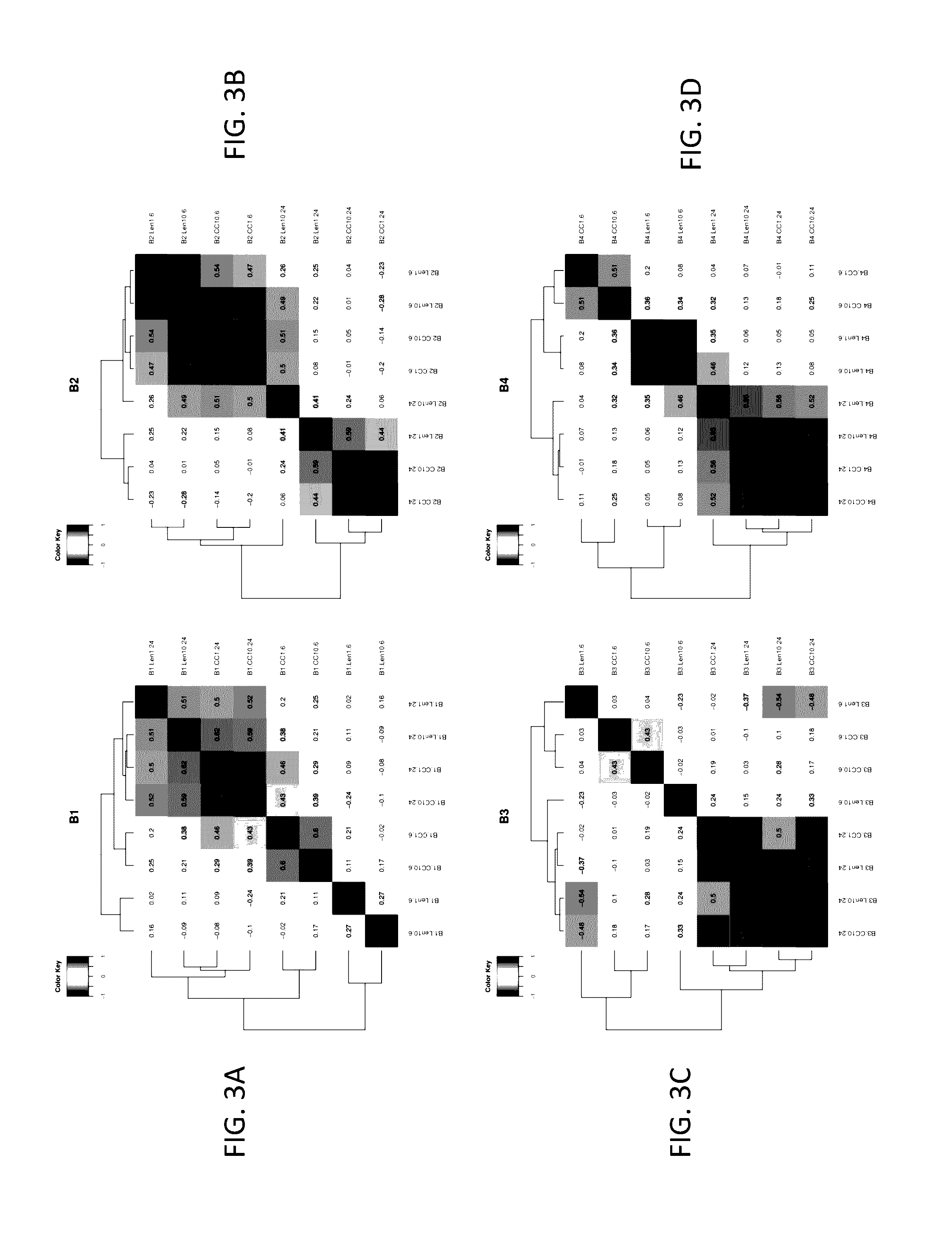Methods for treating chronic lymphocytic leukemia and the use of biomarkers as a predictor of clinical sensitivity to immunomodulatory therapies
a technology of immunomodulatory therapy and lymphocytic leukemia, which is applied in the field of chronic lymphocytic leukemia and the use of biomarkers as a predictor of clinical sensitivity to immunomodulatory therapy, can solve the problems of limited options for cancer treatment, few treatment options available, and large unknown incidence of human leukemia
- Summary
- Abstract
- Description
- Claims
- Application Information
AI Technical Summary
Benefits of technology
Problems solved by technology
Method used
Image
Examples
example 1
6.1 Example 1
Preparation of 3-(4-amino-1-oxo-1,3-dihydro-isoindol-2-yl)-piperidine-2,6-dione (lenalidomide)
Methyl 2-bromomethyl-3-nitrobenzoate
[0510]A stirred mixture of methyl 2-methyl-3-nitrobenzoate (14.0 g, 71.7 mmol) and N-bromosuccinimide (15.3 g, 86.1 mmol) in carbon tetrachloride (200 mL) was heated under gentle reflux for 15 hours while a 100 W bulb situated 2 cm away was shining on the flask. The mixture was filtered and the solid was washed with methylene chloride (50 mL). The filtrate was washed with water (2×100 mL), brine (100 mL) and dried. The solvent was removed in vacuo and the residue was purified by flash chromatography (hexane / ethyl acetate, 8 / 2) to afford 19 g (96%) of the product as a yellow solid: mp 70.0-71.5° C.; 1H NMR (CDCl3) δ 8.12-8.09 (dd, J=1.3 and 7.8 Hz, 1H), 7.97-7.94 (dd, J=1.3 and 8.2 Hz, 1H), 7.54 (t, J=8.0 Hz, 1H). 5.15 (s, 2H), 4.00 (s, 3H); 13C NMR (CDCl3) δ 165.85, 150.58, 134.68, 132.38, 129.08, 127.80, 53.06, 22.69; HPLC, Water Nove-Pak / C1...
example 3
6.3 Example 3
Analysis of Effects of Compound A and Lenalidomide on Primary CLL Samples by TMT-Tagging and Mass-Spectrometry
[0521]This example describes comparative and functional analysis of mass-spectrometry (MS) profiling data from primary CLL patients exposed to lenalidomide or Compound A.
Methods
[0522]Data import: Relative abundance (RA) data was imported into the R statistical programming environment v.3.1.2. Proteins with less than one spectral count in any of the three MS runs for each case scenario were filtered out and relative abundance was scale normalized to the same median by using normalizeBetweenArrays( ) function implemented in the limma package for Bioconductor (see Yang et al., Nucleic Acids Research, 30(4), e15 (2002)).
[0523]Comparative analysis: RA scores were log 2-transformed to perform direct comparison of compounds exposure versus DMSO control and a paired moderated t-test (see Smyth, Statistical Applications in Genetics and Molecular Biology, 3(1), article 3 ...
example 4
6.4 Example 4
Downregulation of PDE6D in Response to Lenalidomide or Compound D Correlated with Inhibition of Cell Growth by the Treatment Compound
Methods
[0556]Cell lines: Ten different CLL cell lines, including EHEB, I83-E95, Mec2, CII, CI, WA-C3-CD5, WA-OSEL, Mec1, PGA1, and HG3, were categorized into four buckets (Bucket #1, Bucket #2, Bucket #3, and Bucket #4) based on their responsiveness to the treatment of lenalidomide or Compound A. Bucket #1 (EHEB and I83-E95) is responsive to both compounds and exhibits similar EC50 values in response to Compound A compared to lenalidomide. Bucket #2 (Mec2, CII, and CI) is responsive to both compounds and is more sensitive to Compound A than to lenalidomide. Bucket #3 (WA-C3-CD5, WA-OSEL, Mec1, and PGA1) is responsive to Compound A but not to lenalidomide. Bucket #4 (HG3) is not responsive to either Compound A or lenalidomide.
[0557]Thymidine incorporation assay: The effects of lenalidomide and Compound A on cell proliferation was assessed b...
PUM
| Property | Measurement | Unit |
|---|---|---|
| Molar density | aaaaa | aaaaa |
| Responsivity | aaaaa | aaaaa |
| Level | aaaaa | aaaaa |
Abstract
Description
Claims
Application Information
 Login to View More
Login to View More - R&D
- Intellectual Property
- Life Sciences
- Materials
- Tech Scout
- Unparalleled Data Quality
- Higher Quality Content
- 60% Fewer Hallucinations
Browse by: Latest US Patents, China's latest patents, Technical Efficacy Thesaurus, Application Domain, Technology Topic, Popular Technical Reports.
© 2025 PatSnap. All rights reserved.Legal|Privacy policy|Modern Slavery Act Transparency Statement|Sitemap|About US| Contact US: help@patsnap.com



